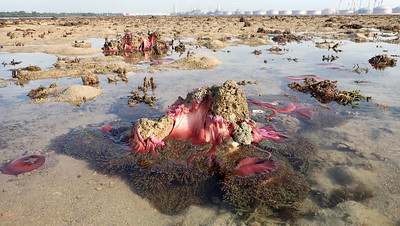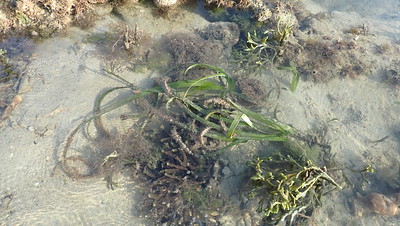Our last survey at Terumbu Semakau was in Jul 2020, just after lockdown was lifted, and when we got the alert that signs of mass coral bleaching were noted during the lockdown. Today, I saw lots of healthy corals, interesting marine life and more signs of a return of seagrasses.
It was a relief to see healthy hard corals and leathery soft corals! At the reef edge, there not many bright white colonies.
I saw a variety of hard corals, most of them healthy. Including some that are usually the first to bleach, like Anchor corals, Cauliflower corals, Brain corals.
However, I saw some Pore corals that were very pale or pinkish. And I saw a few other others with pale or small bleaching portions. But I didn't any mass coral bleaching.There were a lot of Asparagus flowery soft corals, and many leathery soft corals. They were alright.The most eye-poking animals on the shores were the Magnificent anemones. These anemones form clumps. There were also some Giant carpet anemones. I saw the rarer Merten's carpet anemone (with an anemone fish in it) and also a Bubble tip anemone (also with movement of an anemonefish in the tentacles).
One of these things is not a hard coral. It is a cushion star - a sea star with arms that are so short, and a huge body, so the entire animal is almost globular!
The Burrowing giant clam is still there, but we didn't manage to find any Fluted giant clams. There were many colourful crabs, and many small fishes. There were lots of squids zooming around leaving blobs of ink in their panic. I couldn't manage a photo of them, but I did come across squid egg capsules laid on some branching sponges. I also saw a few Diadema sea urchins tucked under large rocks. The only nudibranch I saw is the commonly seen Phyllid nudibranch.The seagrass situation seems similar to what I saw in Jul 2020 and May 2019, i.e., slowly improving. Although heavily covered with epiphytes, there was good cover of Spoon seagrasses in many of the pools in the middle of the reef flat.
There were many clumps of Tape seagrass with longish leaf blades especially those growing nearer the reef edge.
I saw many small clusters of Serrated ribbon seagrass that looked fresh and green.
There used to be lush seagrass meadows on Terumbu Semakau. Here's what the seagrass meadows looked like when we visited in June 2010. Let's hope the seagrasses will return soon!
Large 'holes' near the reef edge with bottoms bare of life are usually a sign of a boat strike on the reef. Such accidents push up a small ridge of dead corals and can wipe out whatever was growing on the surface.
It was a relief not to see any fish traps on the shore today. I noticed that large fish trap that I disabled on our last survey is still there and is starting to become part of the habitat.
I was lucky to get a glimpse of a sea turtle popping its head up to take a breath (no photo) and the boat skipper also saw 3 sea turtles while waiting for us.
Fate of Terumbu Semakau?
Terumbu Semakau lies next to the Semakau Landfill and close to the petrochemical plants on Pulau Bukom.
Terumbu Semakau is one of the existing natural shores that may be impacted by the landuse plan by the Ministry of National Development released in Jan 2013 in response to the Populations White Paper with a 6.9 million population target. The dotted margined blue areas are "Possible Future Reclamation".

The other shores impacted by this plan include Pulau Jong, Pulau Hantu, Terumbu Pempang Darat, Terumbu Pempang Tengah, Terumbu Pempang Laut.

The Singapore Blue Plan 2018
Pulau Semakau and nearby islands and submerged reefs have been recommended by the Singapore Blue Plan 2018 for Immediate Conservation Priority.
The Blue Plan recommends the intertidal and subtidal marine areas of Pulau Semakau and adjacent Pulau Hantu, and Pulau Jong to be designated Marine Reserve.
The Blue Plan highlights that Pulau Semakau and its associated patch reefs comprise many ecosystems: coral reefs, mangrove areas, intertidal sandflats, seagrass meadows, and coral reefs. The subtidal area of Pulau Jong is larger than the terrestrial area. Pulau Hantu is a popular dive site has seen increasing interest in the past decade due to biodiversity awareness. If protection is accorded to these three islands, zonation plans for use can be implemented to manage tourism and human impacts.
DOWNLOAD the Plan, SUPPORT the Plan! More on the Singapore Blue Plan 2018 site.
Photos by others on this survey
Jianlin Liu
Vincent Choo
Marcus Ng
Liz Lim
James Koh on flickr
Others on the survey: Juria Toramae
















